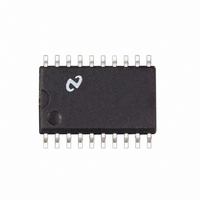LM3647IM National Semiconductor, LM3647IM Datasheet - Page 6

LM3647IM
Manufacturer Part Number
LM3647IM
Description
IC BATT CHARGER UNIVERSAL 20SOIC
Manufacturer
National Semiconductor
Datasheet
1.LM3647IM.pdf
(14 pages)
Specifications of LM3647IM
Function
Charge Management
Battery Type
Li-Ion, NiCd, NiMH
Voltage - Supply
4.5 V ~ 5.5 V
Operating Temperature
-40°C ~ 85°C
Mounting Type
Surface Mount
Package / Case
20-SOIC (0.300", 7.50mm Width)
Lead Free Status / RoHS Status
Lead free / RoHS Compliant
Other names
*LM3647IM
*LM3647IM/NOPB
LM3647IM/NOPB
*LM3647IM/NOPB
LM3647IM/NOPB
Available stocks
Company
Part Number
Manufacturer
Quantity
Price
Company:
Part Number:
LM3647IM
Manufacturer:
NS
Quantity:
5 510
Part Number:
LM3647IM
Manufacturer:
NS/国半
Quantity:
20 000
Company:
Part Number:
LM3647IM-ND
Manufacturer:
NSC
Quantity:
3
www.national.com
4.0 Functional Description
tied to V
source when tied to GND (PWM “slow” frequency). When
configured for Li-Ion batteries, SEL3 switches between 4.1V
cells or 4.2V cells.
Note: SEL3 must be hard wired to V
Note: Current feedback is automatically selected, if LM3647 is configured for
SEL4 is connected to a RC-network that determines the
charge time-outs. This RC-network is also connected to the
output LED1. (See Section 4.3.2 for details).
RCIN is a high-speed timing pin connected to a RC-network,
used to drive the charger at the right operating frequency.
GND is the ground pin.
V
decoupling capacitor tied to GND.
RESET is a reset pin.
LED1 is an active-low output used to indicate charge phase.
It is also used when measuring the charge timeout value.
LED2 is an active-low output used to indicate charge or
discharge. It also sends out digitally what the LM3647 has
read at the mode selection pins and charge timeout.
LED3 is an active-low output used to indicate charge start/
stop and error.
V
uses this pin as a reference when measuring the other
analog inputs. V
reference (e.g., LM4040A - 2.5).
CEXT is a timing pin used by the LM3647, it must be
connected to a low loss capacitor (polyester).
CEL is an analog input that measures the battery voltage via
a resistor divider network.
CS is an analog input that is connected to a differential
amplifier that measures the voltage over a small current
sensing resistor, when used in conjunction with current feed-
back power supply. When the LM3647 is used with a con-
stant current power supply, CS should be connected to the
2.5V voltage reference (pin V
TEMP is an analog input that is connected to the tempera-
ture sensing NTC-resistor (is used). If no temperature sen-
sor is used, the input must be connected to a voltage be-
tween 0.5V to 2.2V.
DISCHG is a digital output that controls a power-FET that
discharges the batteries before charging them. If the dis-
charge function is not used, leave this pin unconnected.
CC
REF
SEL3
SEL3
GND
GND
V
V
is the power-supply pin. This pin should have a 100 nF
and Ni-Cd/Ni-MH is implemented.
Li-Ion charging (pin SEL2 open).
CC
CC
is the voltage reference analog input. The LM3647
CC
(PWM “fast” frequency) or a constant current
Current feedback (“fast” PWM frequency)
No current feedback (external constant
current source) (“slow” PWM frequency)
4.2V/cell
4.1V/cell
output SEL2 = V
REF
PWM Output Frequency Select
has to be connected to a 2.5V voltage
output SEL2 = Open (Li-Ion)
Li-Ion Cell Voltage Select
CC
REF
if a charger that supports both Li-Ion
CC
).
(NiMH) or GND (NiCd)
(Continued)
6
SYSOK is an open drain output that resets the LM3647 in
the rare case of an internal illegal operating condition. This
pin is connected to the RESET pin to increase reliable
operation of the device in hostile operating environments
(e.g., noisy environments).
BUZZER is a digital output that controls a small FET and
turns an optional buzzer on and off. The buzzer must have
it’s own oscillator drive circuitry.
PWM is a digital output that controls the charge voltage or
turns the external current source on and off (depending on
mode-selection).
4.3 CONFIGURATIONS
4.3.1 Maximum Battery Voltage
The maximum battery voltage corresponds to the number of
battery cells. The resistor network in the figure below scales
the battery voltage to a level suitable for the LM3647. For
Ni-Cd/Ni-MH batteries the tolerance of the network is not
critical, and only defines the maximum battery voltage
(which is used as a backup termination method). For Li-Ion
batteries the network must be more accurate, and resistors
with low tolerances must be used (1% or better).
Ni-Cd/Ni-MH
Each battery cell is at nominal voltage 1.2V, but the critical
voltage is rather the maximum voltage per cell specified at
1.85V. The maximum cell voltage is used for maximum
voltage error termination. If a Ni-Cd/Ni-MH cell fails, it either
becomes shorted or goes high impedance. In the case of
high impedance the cell voltage will reach 1.85V. By multi-
plying the number of cells with the maximum cell voltage, the
Maximum Battery Voltage (V
When the maximum battery voltage has been determined,
the voltage divider network can be dimensioned using the
following formula (SEL2 connected to V
Batm
) is achieved.
10131807
CC
or GND):











